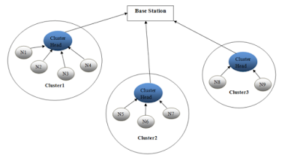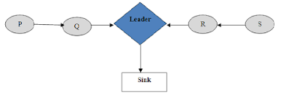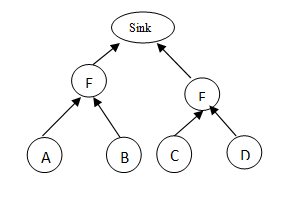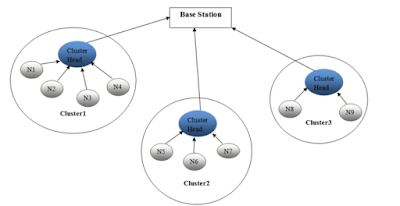Table of Contents
Types of Wireless Sensor Networks
In this wireless sensor networks-based tutorial, we will learn about wireless sensor network introduction, types of wireless sensor networks, and its limitation.
This type of wireless sensor networks tutorial aims to provide knowledge about WSN and its concepts to computer science graduates, postgraduates, and researchers.
Frequently Asked Questions
After reading this tutorial, students will be able to answer the following questions
- What are wireless sensor networks?
- How does data is transmitted in wireless sensor networks?
- Explain data aggregation in wireless sensor networks?
- What are different data collection techniques in wireless sensor networks?
- How does flat network-based win work?
- What are different flat networks-based data collection techniques in wireless sensor networks?
- How does a hierarchical wireless sensor network work?
- What do you understand by Flooding in the win?
- What is gradient-based routing in the win?
- What is direct Diffusion in wireless sensor networks?
- Explain the cluster-based architecture of wireless sensor networks?
- What do you mean by chain-based architecture wireless sensor network?
- Explain the tree-based architecture of wireless sensor networks.
What is Wireless Sensor Networks?
A wireless sensor network comprises a large number of sensor nodes and one or more sink nodes (base stations). The number of sensor nodes and sink nodes depends on the types of wireless sensor networks.
The sensor nodes are deployed inside the area of interest to collect valuable information from the surrounding environment and report it to a base station located generally at the extremity of the area of interest.
For example, the sensor nodes can monitor and report certain events like the movement of objects. The role of the base station is to gather the information sent by the sensor nodes and send it back to the user (control node), and eventually send queries to the sensor nodes. Generally, the base station is much more potent in terms of resources than the sensor nodes.
Energy Constraint in Wireless Sensor Networks
In a wireless sensor network, sensor nodes are energy-constrained. If all the sensor nodes transmit their sensed data directly to the base station, it consumes a lot of the energy of sensor nodes and decreases the network lifetime.
To maximize the lifetime of wireless sensor networks, various architectures are used. These architectures of WSN or types of wireless sensor networks help in maximizing the lifetime of WSN.
Types of Wireless Sensor Networks
Different types of wireless sensor networks have been evolved for transmitting the data from the source node to the destination node.
Generally, there are two types of architectures for data transmission and data collection in wireless sensor networks.
A.Flat Network-Based Architecture
B.Hierarchical Networks Based Architecture
Let’s start with Flat Network-Based Architecture first.
A. Flat Network-Based Architectures of WSN
In a flat network, each sensor node plays the same role and has some features. In such networks, data collection is performed in a data-centric manner where the sink node generally sends a query message to the sensor node, for example, via Flooding.
The sensors which have data matching to the query send a response to the sink node. Some data collection techniques which are used in the flat network are as follows:
1.Flooding and Gossiping
Researcher W.R. Heinzelman proposed adaptive protocols for information dissemination in wireless sensor networks in which the flooding technique is used.
In flooding each sensor that received the Sink query message, broadcast that message to its neighbors, and this process continues until the message reached the destination or a maximum number of hops for the packet is reached.
Gossiping is a slightly enhanced version of Flooding where the receiving node sends the packet to a randomly selected neighbor, which picks another random neighbor to forward the packet.
The gossiping will not broadcast the packets as Flooding and thus overcomes the implosion problem as any node will have a single copy of the packet to be sent. However, this may induce delays in transmitting the data to all other nodes.
2.Direct Diffusion
Direct Diffusion is a data-centric and application-aware paradigm in the sense that the attribute-value pairs name all the data generated by the sensor nodes.
In direct Diffusion, the base station requests data by broadcasting task to be performed by the network. This task is defined using a list of attribute pairs such as the name of the object, interval duration, and geographical area.
3.Sensor Protocols for Information via Negotiation (SPIN)
The idea behind the SPIN is to name the data using high-level descriptors or Metadata. Metadata is exchanged among the sensors before transmission via a data advertisement mechanism, which is the crucial feature of SPIN. You can read the complete SPIN protocol for WSN here.
Each node, upon receiving new data, advertises it to its neighbors. It is a variation of direct Diffusion. In rumor routing, the idea is to route the queries to the nodes that have observed a particular event rather than flooding the entire network to retrieve information about occurring events.
4.Gradient Based Routing
In the gradient-based routing technique, the key idea is to memorize the number of hops when the queries are diffused throughout the network. Each node calculates the parameter height of the node, which is the minimum number of nodes required to reach the base station.
The difference between the node height and its neighbor is called the gradient of the link.
After Flat Network types of Wireless Sensor Network let us see Hierarchical Network-Based Architecture.
B. Hierarchical Network-Based Architecture
In hierarchical types of wireless sensor networks, nodes are arranged at a different level for transmitting data to the sink node. The hierarchical network may be in the form of cluster, tree, grid, and chain.
In energy-constrained sensor networks of considerable size, it is inefficient for sensors to transmit the Sink data directly. In such scenarios, sensors can transmit data to a local node at the upper level or cluster head, which collects the data from all the sensors in its cluster and transmits it to the Sink.
This results in significant energy savings for the energy-constrained sensors.
Different types of hierarchical based architectures of wireless sensor networks are as follows:

Figure 1: Cluster Based Architecture
2.Chain Based Architecture
In chain based data transmission and data collection architecture each sensor sends data to its closer neighbor. All sensors are structured into a linear chain for data collection.
S. Lindsey and C. Raghavendra proposed a Power Efficient Data Gathering Protocol for Sensor Information system (PEGASIS), which is a chain based protocol in which nodes can form a chain using greedy algorithm. You can study complete PEGASIS Protocol here.
Greedy chain formation assumes that all the nodes have the global information about the network. The farthest nodes from the sink initiate the chain formation and each step the closest neighbor of a node is selected as its successor in the chain.

Figure 2: Chain Based Architecture
Figures 2 represents the chain based architecture in which sensor node P and S initiates the chain formation and send their data to their neighbor nodes Q and R respectively and these nodes send data to Leader node. Leader sensor node is the node which is very near to Sink.
3. Tree Based Architecture
In tree-based architecture for data transmission and data collection, nodes are arranged at different levels, and the tree is rooted at the sink node, and the source nodes work as leaves nodes. A node has a parent node, and it forwards data to it.
Data flow starts from the source node to the Sink through parent nodes. One of the essential aspects of the tree-based approach is to construct an energy-efficient data collection tree.
An example to illustrate the data transmission and data collection using tree-based architecture in a wireless sensor network is shown in Figure 3.
It is shown in the figure that source nodes A and B forward their sensed data to their parent node E. Similarly, source nodes C and D send their sensed data to their parent node F. Parent node E and F forward the collected data to the Sink.

Figure 3: Tree-Based Architecture
Please provide your feedback or leave a comment so that we can improve and provide you a good quality tutorial.
If you find this page helpful, then please Like and Share the post on Facebook, Twitter, Linkedin through their icons as given below.



